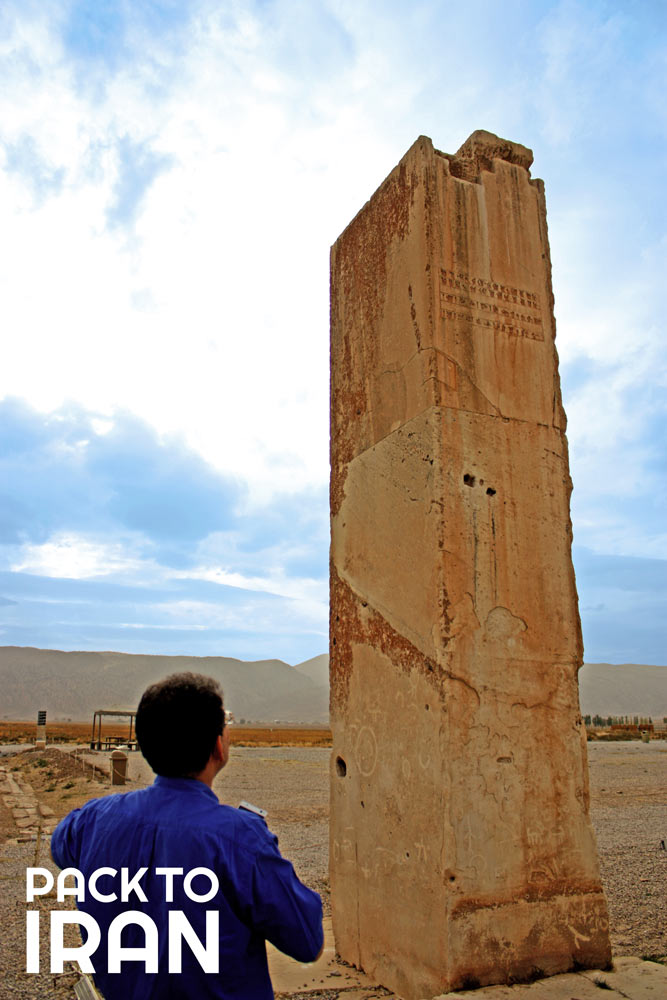Pasargadae (In Persian Pasargad) was the first dynastic capital of the Achaemenid Empire which was constructed by the order of Cyrus II the Great (reigned 559–c. 529 BCE). This magnificent ancient UNESCO World Heritage site is located in the plain of Murghab near the river Polvar, in the heart of Pars province, the cradle of the Persian Empire. The name of the city as Herodotus says, may have been derived from that of the main Persian tribe, the Pasargadae, although it is believed that the original form of the name was Parsagadeh (meaning: Throne of Pars).
Pasargadae’s monuments including the ruins of Cyrus’s palaces, the gardens, and his outstanding mausoleum are excellent examples of the first phase of royal Achaemenid architectural art and exceptional evidence of Persian civilization. Even though after the construction of the fabulous palaces of Persepolis by Darius I (reigned 521- 486 BCE), Pasargadae lost its importance as a capital, but in fact, the majestic simplicity of its architecture reflects a sense of balance and beauty that was never equaled in either earlier or later Achaemenian times. Pasargadae includes the compact limestone tomb of Cyrus the Great, Tall-e Takht (“Solomon’s Throne”), a great fortified platform built on a hill which was later incorporated into a sprawling citadel with substantial mud-brick defenses, and the royal ensemble, which consists of several palaces originally located within a garden layout (the so-called “Four Gardens”). It is important to be mentioned that Pasargadae became a prototype for the Persian Garden concept of four quadrants formally divided by waterways or pathways, its architecture characterized by refined details and slender verticality.
Pasargadae - Iran
Excavations in Pasargadae
Archeological excavation in Pasargadae was started in the early 20th century. The first and the second seasons of excavation were done by the German archaeologist, “Ernst Herzfeld” in 1905 and 1928, and then the excavations were continued by archaeologists like “Sir Aurel Stein” in 1934. From 1949 to 1955 an Iranian team led by Mr. Ali Sami was consigned to perform further excavations and studies. And then, the British Institute of Persian Studies led by Mr. David Stornach resumed the excavations and worked on the site from 1961 to 1963.
Tomb of Cyrus the Great
Still standing intact, the Tomb of Cyrus the Great structurally consists of two distinct parts: a high platform composed of six receding stages and a tomb chamber on the top with a gable roof. The entire monument which is around 11-meters-high reminds us of the form of the Mesopotamian ziggurat temples. According to the Greek historian Arrian, on the way to India (in 324 BCE), Alexander the Great decided to visit Pasargadae and the tomb of Cyrus! He found Cyrus's tomb in a nice garden, and ordered that they open the door of the tomb and as Alexander entered, he found the body laid in a gold coffin on a gold coach! Alexander presented some gifts to his tomb and moved toward India. Back from India, Alexander was shocked and sorry after finding the tomb open and looted. Alexander’s general Aristobulus, who was charged with restoring the tomb, also left some descriptions not only of the interior furnishings of the monument, where the body of Cyrus the Great laid but also of the tomb’s exterior details, including a description of the well-watered and lush gardens that once surrounded the tomb.
During the medieval period, the monument was thought to be the tomb of King Solomon's mother, so it became a sacred place for the people to the extent that it became an Islamic pilgrimage site and a small mosque was built near the tomb by using the columns and stones of the remains of the ancient palaces and was in use until the 14th century. In the 1970s during a restoration, the remains of the mosque were taken back to the place they belong to, and the ancient pieces of columns were placed close to their original location.

Tomb of Cyrus the Great - Pasargadae - Iran
The royal ensemble
In the huge plain of Pasargadae on more or less level ground, was an extensive walled park with elaborate irrigated gardens surrounded by a series of royal buildings including; the private palace of Cyrus, The Audience Hall, The Entrance gate and a monument which is known as Cambyses’ ( son of Cyrus the Great)Tomb.
The Private Palace of Cyrus the Great
The Private Palace has a simple plan with a central columned hall opened by stone doorways in all four walls. The west and east sides of the private palace were fronted by porticoes, with remains of a stone throne facing the lush gardens of Pasargadae. The low roof of this hall was supported by a large number of columns, arranged in five rows of six. There is a cuneiform inscription on one of the walls that say: I am Cyrus, the Achaemenid King. This inscription is written in three different languages. Old Persian, Babylonian, and Elamite.

The inscription in the Private Palace of Cyrus the Great - Pasargadae - Iran
The Audience Hall
This hypostyle hall has two rows of four columns, with foundations made of dark gray limestone, shafts made out of white limestone, and the capitals were in black stone. There is evidence of the column capitals representing hybrid, horned animals such as lions or maybe bulls. The palace had a portico on each side. Some of the bas-reliefs of the doorways are preserved, showing human figures and monsters, one of which is a mysterious creature which is a mixture of a man and a fish! The three lingual cuneiform inscription of the private palace is copied at the Audience Hall, too.

The remains of the columns in the Audience Hall - Pasargadae - Iran
The Entrance Hall
Unfortunately, this palace is badly damaged and only some parts of the bases of its eight columns have left and today they are covered with a brick wall to be protected from further damages. Another significant part of this hall is the jamb of one of its gateways, where a very special relief is carved on and is preserved miraculously. The relief shows a four-winged bearded man wearing a strange crown similar to the Egyptian crowns and a full-length robe that passes over his right arm. The right hand is raised in front of the chest with the fingers fully extended while the left hand is less preserved. This winged figure is inspired by Assyrian and pre-Achaemenid art.
-min.jpg)
The "Wingman" relief in the Entrance Hall - pasargadae - Iran
Tal-e Takht (Solomon’s Throne)
The Tal-e Takht refers to a citadel on a hill at the northern limit of Pasargadae which dominates the whole plain and it’s believed that its first phase of the construction was built by Cyrus the Great, stopped at his death in 530 BCE. The second phase was built under Darius the Great (521-486 BCE), using mud brick construction instead of the stone blocks which were used during its first phase of construction.
The Stone Tower or Solomon’s Prison
Stone tower or Solomon’s Prison is a fourteen-meter-high tower where only one of the walls has been preserved. This tower façade is made from finely cut slabs of a light color limestone. The function of this stone tower is not exactly known yet but it’s believed that the building could have been a fire temple, the tomb of Cambyses (Cyrus’s sun), or a treasury.

The Stone Tower - Pasaragade - Iran
Visiting Pasargadae
Located 120 kilometers away from Shiraz, Pasargadae is one of the most important sites around this city. Whether you are visiting this site on the way from Yazd to Shiraz or you take a Pasargadae tour from Shiraz, you should start your road trip early in the morning so that you have enough time for visiting all the palaces and and halls of Pasargadae and visiting the two other ancient Achaemenid sites around Shiraz, Persepolis and Necropolis.
-min.jpg)
Travelers visiting the "Wingman" relief - Pasaragade - Iran


-min.jpg)
